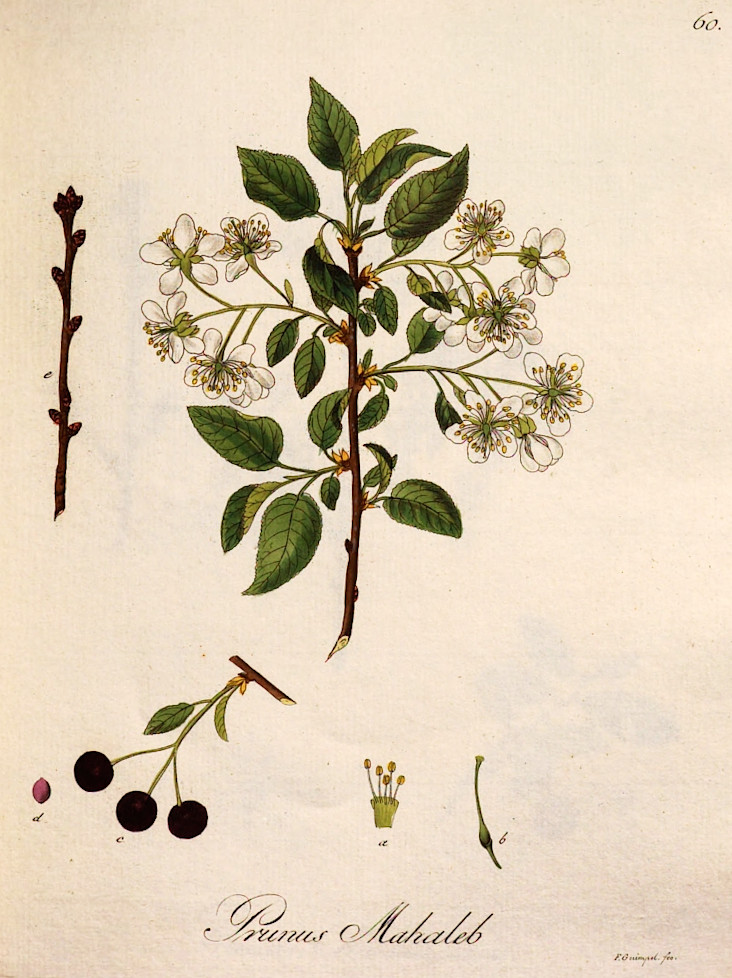Dies ist eine alte Version des Dokuments!
Prunus mahaleb L. - Rosaceae - mahaleb cherry, St.Lucie cherry, perfumed cherry, Steinweichsel, Felsenkirsche
Deciduous shrub or tree, native to central and southern Europe, naturalised and introduced elsewhere as a rootstock for commercial cherries; stem and twigs not thorny, bark grey-brown, twigs with terminal end buds; leaves petioled (4-20mm), broadly ovate, oblong, or suborbiculate, base usually rounded to truncate, sometimes subcordate, margins crenate; inflorescences corymbs 4-10-flowered, flowers fragrant, blooming at leaf emergence, petals white, elliptic to obovate, 6-7mm; fruit small, thin-fleshed, cherry-like drupe 6-10mm in diameter, green turning red to dark purple and black when mature, very bitter; stones ellipsoid to subglobose.
Steinweichsel (wikipedia) Prunus mahaleb in Flora of North America
„Its fruits are small, slightly bitter and edible, from which a purple dye is obtained. The seeds are
used more. An aromatic spice is produced, having a taste similar to almond seeds. This spice was used for centuries in the Middle East and North Africa to flavour bread, cakes, cheese, cookies, etc.“
[Popescu, I., and G. Caudullo. „Prunus mahaleb in Europe: distribution, habitat, usage and threats.“ 2020] PDF
Volatile components of the fruit kernel included dihydrocoumain, coumarin, and herniarin (7-methoxycoumarin).
[Al-Said, Mansour S., and Mohamed S. Hifnawy. „Dihydrocoumarin and certain other coumarins from Prunus mahaleb seeds.“ Journal of Natural Products 49.4 (1986): 721-721]
„Volatile constituents from air-dried flowers, leaves, stem-bark and wood of Prunus mahaleb L. (Rosaceae) were isolated by steam-distillation and analysed using GC and GC-MS.“ Main components of the bark volatiles were coumarin (34.1%), hexadecanoic acid (9.3%) and linoleic acid (5.3%); minor components include nonanal (1.1%), (E)-2-nonenal (1.3%), (E,Z)-2,6-nonadienal (0.2%), decanal (0.7%), 2-dodecenal (0.2%), (E,E)-2,4-decadienal (0.5%), linalool (0.6%), borneol (0.8%), α-terpineol (0.5%), thymol (0.3%), (E)-nerolidol (0.4%), benzaldehyde (0.3%), and dihydrocoumarin (0.6%). Main components of the wood volatiles were eicosane (46.0%) and hexadecanoic acid (12.9%), minor ones included coumarin (4.5%).
Main components of the dried flower volatiles were heneicosane (22.1%) and octacosane (13.0%); minor components included e.g. nonanal (1.9%), 2-dodecenal (0.1%), tridecanal (0.3%), tetradecanal (0.4%), limonene 0.3%), linalool (4.1%), α-terpineol (1.4%), 2-caren-4-one (4.8%), nerol (0.5%), geraniol (1.3%), (E)-β-damascenone (0.9%), (E)-β-ionone (1.3%), (E)-nerolidol (0.2%), benzaldehyde (0.2%), anisaldehyde (0.7%), 1,4-dimethoxybenzene (2.2%), 2-phenylethanol (0.5%), p-tolualdehyde (1.0%), coumarin (2.3%), hexyl benzoate (0.8%), methyl 2-methoxybenzoate (0.2%), and (Z)-jasmone (0.2%).
[Mastelić, Josip, Igor Jerković, and Milan Mesić. „Volatile constituents from flowers, leaves, bark and wood of Prunus mahaleb L.“ Flavour and fragrance journal 21.2 (2006): 306-313]
Prunus mahaleb L. honey: „High vomifoliol percentages (10.7-24.2%) in both extracts (dominant in solvent B) and coumarin (0.3-2.4%) from the extracts (more abundant in solvent A) and headspace (0.9-1.8%) were considered characteristic for P. mahaleb honey and highlighted as potential nonspecific biomarkers of the honey’s botanical origin.“
Other volatiles isolated by HS-SPME (PDMS/DVB) were e.g. anisaldehyde (1.4-10.9%), benzaladehyde (2.0-4.5%), phenylacetaldehyde (0.5-2.8%), linalool (4.0-6.6%), lilac aldehydes (1.0-11.7%), lilac alcohols (0.1-1.2%), cis- and trans-linalool oxide (0.6-3.1%), 4-ketoisophorone (5.0-7.4%), α-isophorone (2.1-6.5%), 2-hydroxyisophorone (0-0.9%), 2-hydroxy-4-ketoisophorone (0-0.6%)] and safranal (0-1.0%).
[Jerković, Igor, Zvonimir Marijanović, and Mladenka Malenica Staver. „Screening of natural organic volatiles from Prunus mahaleb L. honey: coumarin and vomifoliol as nonspecific biomarkers.“ Molecules 16.3 (2011): 2507-2518]
Coumarin content in Prunus mahaleb kernels was 0.87mg/g and in ‘Mirinello di Torremaggiore’ liqueur it was 740mg/L.
[Ieri, Francesca, Patrizia Pinelli, and Annalisa Romani. „Simultaneous determination of anthocyanins, coumarins and phenolic acids in fruits, kernels and liqueur of Prunus mahaleb L.“ Food chemistry 135.4 (2012): 2157-2162] PDF

Guimpel, F., Willdenow, C.L., Hayne, F.G., Abbildung der Deutsche Holzarten (1815-1820) Abbild. Deut. Holzart.
vol. 1 (1815) t. 60
http://plantillustrations.org/species.php?id_species=1265883

Prunus mahaleb flowering, CC BY-SA 3.0 Author: Andreas Kraska

